Spin to Win: How Gamified Widgets Drive Higher Conversions
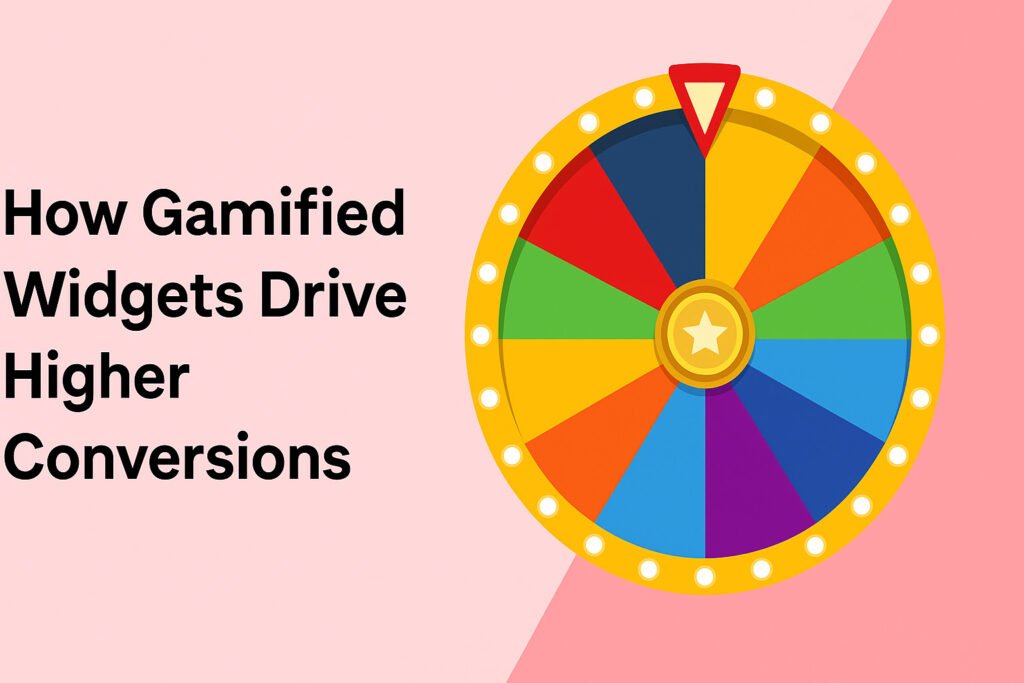
In today’s fast-moving D2C landscape, customer attention is fleeting and conversions are harder to earn. One strategy that consistently works? Gamified experiences like Spin to Win widgets. These interactive popups don’t just entertain—they convert. They reduce bounce rates, collect high-quality leads, and deliver a compelling brand experience that sets you apart. 1. What Is a Spin to Win Widget? A Spin to Win widget is a gamified popup or embedded tool that allows users to spin a digital wheel for a chance to win a reward—such as a discount, free shipping, or a special gift. This game-like approach encourages participation and adds excitement to the browsing experience, turning passive visitors into active users. 2. Why Gamification Works in E-commerce Gamification leverages core psychological drivers such as curiosity, competition, and the desire for instant rewards. When used strategically in eCommerce, it results in: 3. How Spin to Win Widgets Improve Conversions Studies show that adding a gamified popup can lift your website’s conversion rate by 10–30%. Here’s why: 4. Ideal Use Cases for D2C Brands Whether you’re a skincare startup or a fashion brand, Spin to Win popups can be a high-impact tactic for: D2C brands serving different tiers or regions—like Delhi NCR, Bangalore, or Pune—can set up custom wheels tailored by pincode or city using IP-based personalization. 5. How TheBotMode Powers Spin to Win Campaigns TheBotMode enables D2C brands to launch advanced spin-to-win experiences with full backend automation and WhatsApp connectivity. Our key features include: 6. Best Practices for High-Performing Spin Widgets To get the most from your Spin to Win campaign, follow these guidelines: Conclusion: Gamify to Convert If you’re a D2C brand looking to break through the noise, gamified tools like Spin to Win widgets can be your growth lever. When combined with WhatsApp follow-ups and automated lead nurturing, the results multiply. Don’t just attract traffic—convert it. Ready to gamify your store? Let TheBotMode help you spin the wheel towards higher conversions. FAQs Q1. Are Spin to Win widgets mobile-friendly? Yes, modern spin popups are fully responsive and work seamlessly across mobile, tablet, and desktop. Q2. Can I control the prizes and winning logic? Yes. With TheBotMode, you can customize each wheel segment, prize probability, and expiration logic. Q3. Is it compliant with data privacy laws like GDPR? Yes. The widget includes opt-in checkboxes and transparent privacy notices to ensure compliance. Q4. How does it integrate with WhatsApp marketing? TheBotMode allows you to capture leads via the spin and automatically trigger WhatsApp flows for reminders, coupons, and follow-ups.
5 Ways WhatsApp Can Improve Your Customer Experience in D2C
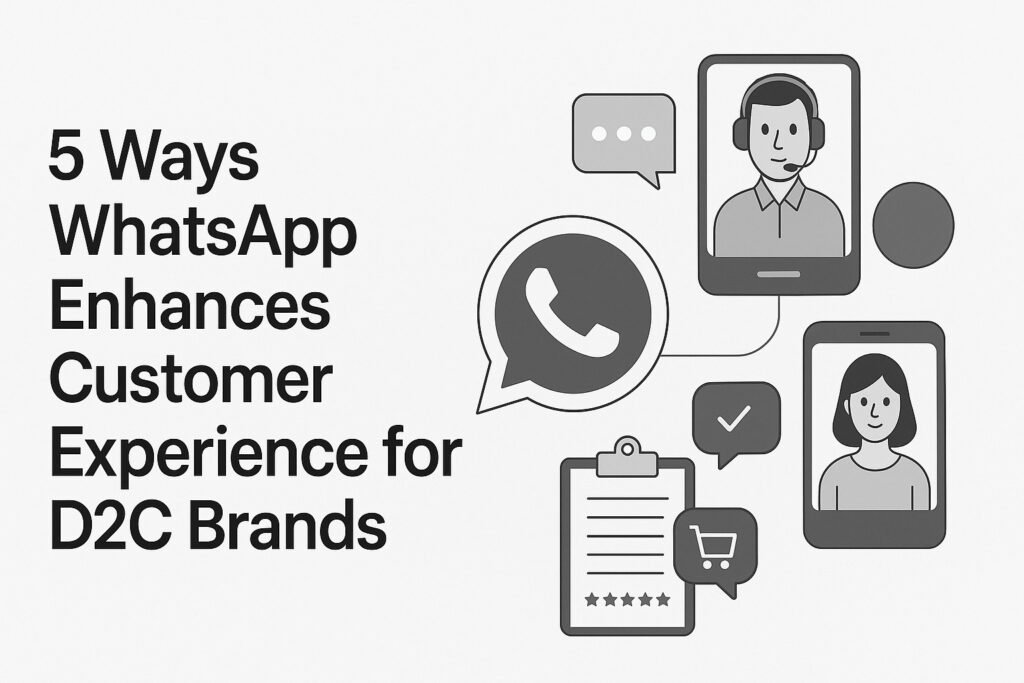
In the highly competitive world of direct-to-consumer (D2C) commerce, delivering a standout customer experience isn’t optional—it’s essential. Today’s consumers expect instant responses, personalized journeys, and seamless service across every touchpoint. This is where WhatsApp steps in as a powerful ally. Here are five impactful ways WhatsApp transforms customer experience for D2C brands. 1. Instant Customer Support, 24/7 WhatsApp enables real-time communication, eliminating the delays of email or call queues. Whether it’s pre-sales inquiries or post-purchase issues, customers can connect with your brand anytime. Benefits: With TheBotMode, you can deploy AI-powered chatbots or pre-set automated flows that answer FAQs, track orders, and escalate complex issues to human agents—ensuring customers feel supported around the clock. 2. Personalized Shopping Journeys Gone are the days of one-size-fits-all marketing. WhatsApp allows you to deliver personalized product recommendations and promotional messages based on browsing history and customer behavior. Example Scenarios: These timely, relevant messages feel more like a helpful nudge than a sales pitch—boosting engagement and conversions. 3. Seamless Order Updates and Notifications One of the simplest yet most appreciated features of WhatsApp for D2C brands is automated order communication. Keep customers informed at every step. Use Cases: These real-time alerts reduce customer anxiety and cut down support tickets asking, “Where is my order?” 4. Automated Feedback Collection Gathering feedback is critical for improving products and services, but long surveys often go ignored. WhatsApp simplifies the process with short, conversational prompts. How it helps: Using TheBotMode’s feedback automation, you can collect insights consistently without overwhelming the customer. 5. Human-Like Conversations at Scale WhatsApp Business API, combined with AI and chatbot technology, allows brands to scale conversations without losing the human touch. Key Features: This balance ensures personalized, efficient service—even at high volumes—while keeping operational costs under control. Conclusion For D2C brands, WhatsApp is not just a messaging tool—it’s a comprehensive platform to elevate customer experience. From instant support and personalized offers to automated updates and human-like interaction at scale, it empowers brands to build lasting customer relationships. With TheBotMode, you can unlock the full potential of WhatsApp Business API to deliver smarter, faster, and more delightful experiences in 2025 and beyond. FAQs Q1. How does WhatsApp improve customer satisfaction for D2C brands? By offering instant support, proactive updates, and personalized engagement, WhatsApp reduces friction and builds trust—resulting in improved customer satisfaction. Q2. Can small D2C brands use WhatsApp Business API effectively? Absolutely. Platforms like TheBotMode make it easy and affordable for small and mid-sized brands to automate conversations, support, and marketing on WhatsApp. Q3. Is it safe to send order updates and payment details over WhatsApp? Yes. The WhatsApp Business API is end-to-end encrypted and adheres to global standards for secure business communication. Q4. How can I automate customer service on WhatsApp? With TheBotMode, you can set up intelligent chatbot flows, quick reply buttons, ticketing systems, and escalation triggers—all within WhatsApp.
Future of Marketing Automation: WhatsApp, AI & Chatbots
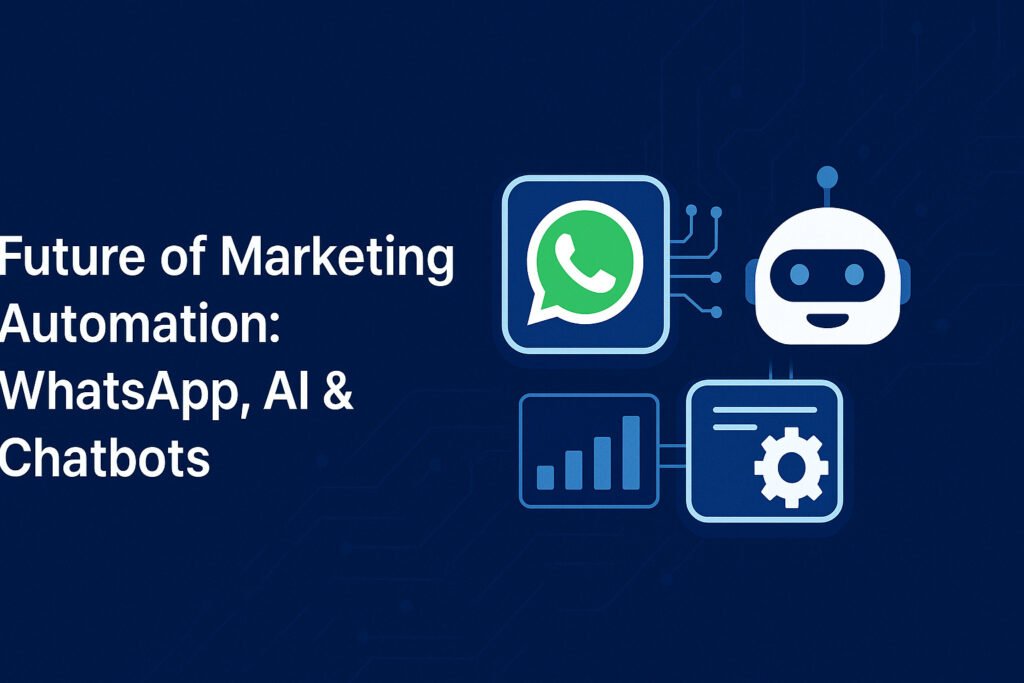
Introduction In 2025, the question isn’t whether you should automate your marketing—it’s how intelligently you do it. As consumers demand instant communication and tailored experiences, platforms like WhatsApp, when powered by AI and chatbot technology, have become essential for direct-to-consumer (D2C) brands. This article explores how WhatsApp Business API, artificial intelligence, and intelligent automation are redefining marketing strategies for eCommerce and D2C brands. 1. The Rise of Conversational Commerce Traditional email campaigns and static websites are no longer enough. Today’s consumers expect real-time interaction and personalized experiences across channels they already use—like WhatsApp. Conversational commerce enables real-time, two-way interaction between brands and customers. WhatsApp, being the most widely used messaging app, is at the heart of this transformation, allowing brands to humanize automation and build relationships at scale. 2. Why WhatsApp Business API Is Leading the Change The WhatsApp Business API empowers brands to scale their communication while remaining compliant and efficient. Its core features include: These capabilities allow brands to connect with customers in real time. When integrated with AI-driven flows, the API becomes a conversion tool that replicates human conversation—without human limitations. 3. Role of AI in Marketing Automation AI has evolved from a predictive tool into an interactive force. Here’s how it is driving the future of automation: When combined with WhatsApp, AI ensures that each campaign is timely, personalized, and optimized for performance. 4. Chatbots: The Always-On Sales Representatives AI-powered WhatsApp chatbots are more than support tools—they’re frontline sales agents. With the right design, they can: A well-built chatbot not only saves time but actively drives conversions throughout the customer journey. 5. Real Use Case: How D2C Brands Are Winning with Automation TheBotMode enables D2C brands to build intelligent automation on WhatsApp using AI chatbots. Here’s a typical flow: The result? Higher engagement, lower abandonment, and improved return on investment (ROI). 6. Future-Proofing Your Brand with Automation In a competitive landscape, brands that leverage multi-layered automation—combining WhatsApp, AI, chatbots, and real-time analytics—will lead the market. Key advantages include: Future-ready brands don’t wait for trends—they build with them in mind. Final Thoughts The future of marketing automation is real-time, AI-driven, and personalized. WhatsApp, combined with TheBotMode’s automation engine, helps D2C brands build high-performing customer experiences that are scalable, smart, and effective. Marketing is no longer about one-way messages—it’s about conversations that convert. FAQs Q1. Is WhatsApp Business API better than the regular app for automation? Yes. The API offers advanced features like automation, chatbots, and scalability, which are not possible on the regular WhatsApp Business App. Q2. Can small D2C brands afford WhatsApp automation? Absolutely. Platforms like TheBotMode offer flexible, scalable solutions that work for startups as well as high-growth brands. Q3. How does AI improve WhatsApp marketing? AI enables dynamic, personalized messaging, predicts customer behavior, and enhances campaign performance through continuous learning. Q4. What industries can benefit from WhatsApp marketing automation? E-commerce, fashion, personal care, healthcare, education, and local services all benefit from WhatsApp automation.
Top WhatsApp Marketing Trends Every Brand Must Know

Introduction In 2025, WhatsApp marketing has evolved into a primary channel for D2C brands aiming to connect with customers at scale. With over 2 billion active users and widespread adoption of the WhatsApp Business API, brands are utilizing the platform for everything from customer service and cart recovery to personalized promotions and payments. In this blog, we’ll uncover the top WhatsApp marketing trends that are redefining the future of eCommerce and customer engagement in 2025. 1. WhatsApp Automation for Faster Customer Engagement With rising expectations for instant support, automation is no longer a nice-to-have—it’s a necessity. Brands are deploying WhatsApp chatbots to handle FAQs, process order tracking requests, and qualify leads in real time. Why it matters: 2. AI-Powered Personalization D2C brands are integrating AI and machine learning into their WhatsApp strategy to deliver hyper-personalized messages. From product suggestions to timely reminders, these systems respond intelligently to user behavior, preferences, and purchase history. Trend impact: 3. Catalog and One-Click Shopping via WhatsApp The WhatsApp Business Catalog allows users to browse and buy directly within the app. Brands can showcase products with images, pricing, and descriptions, and even integrate with one-click checkout flows. Benefits: 4. Automated Order Updates and Cart Recovery Brands are leveraging WhatsApp for transactional updates such as: These updates improve transparency and reduce WISMO (“Where Is My Order”) queries. 5. WhatsApp Retargeting and CRM Integration By connecting WhatsApp with CRMs, brands can sync customer data to run highly targeted campaigns. You can segment audiences based on behavior, location, and purchase history to retarget cold leads and improve conversions. 6. Voice Notes and Multimedia Messaging Brands are adopting rich media formats—like videos, voice notes, and PDFs—for tutorials, product launches, and welcome messages. These formats capture attention better than plain text and humanize communication. 7. Consent-Driven Marketing and Compliance WhatsApp’s 2025 policies require strict opt-in mechanisms and easy opt-outs. Brands must follow consent-first strategies to remain compliant with GDPR and India’s DPDP regulations. Key takeaway: 8. Regional and Multilingual Campaigns Brands are reaching deeper into Tier 2 and Tier 3 cities by running campaigns in regional languages such as Hindi, Tamil, Bengali, and Marathi. Multilingual marketing ensures relevance and stronger emotional connection. 9. WhatsApp Click-to-Chat Ads Meta’s Click-to-WhatsApp ads continue to rise in popularity. These ads, shown on Facebook or Instagram, open a direct chat with the brand—accelerating lead capture and real-time engagement. 10. Integration with Payment Systems With UPI integration, WhatsApp is now a complete commerce platform. Customers can: Conclusion As customer behavior evolves, WhatsApp will remain central to digital-first engagement. Brands that adopt these trends—automation, personalization, compliance, and localization—will outperform competitors by delivering faster, more relevant, and frictionless experiences. 2025 marks a turning point in WhatsApp’s transformation from a messaging app into a full-fledged commerce and customer engagement engine. FAQs What are the top WhatsApp marketing trends in 2025? The leading trends include automation, AI-driven personalization, WhatsApp catalogs, CRM retargeting, multilingual messaging, and payment integrations. How can D2C brands benefit from WhatsApp marketing? WhatsApp enables brands to automate support, recover abandoned carts, personalize outreach, and boost repeat purchases, all while maintaining real-time interaction. Is WhatsApp marketing better than email marketing? WhatsApp campaigns often see significantly higher open and response rates than email, making it ideal for mobile-first, time-sensitive, and conversational engagement. Are WhatsApp campaigns GDPR and DPDP compliant? Yes—if brands follow opt-in requirements, provide clear consent, and offer opt-out options, they can remain compliant with both GDPR and India’s Data Protection Bill.
Top WhatsApp Marketing Automation Tools Every D2C Brand Needs
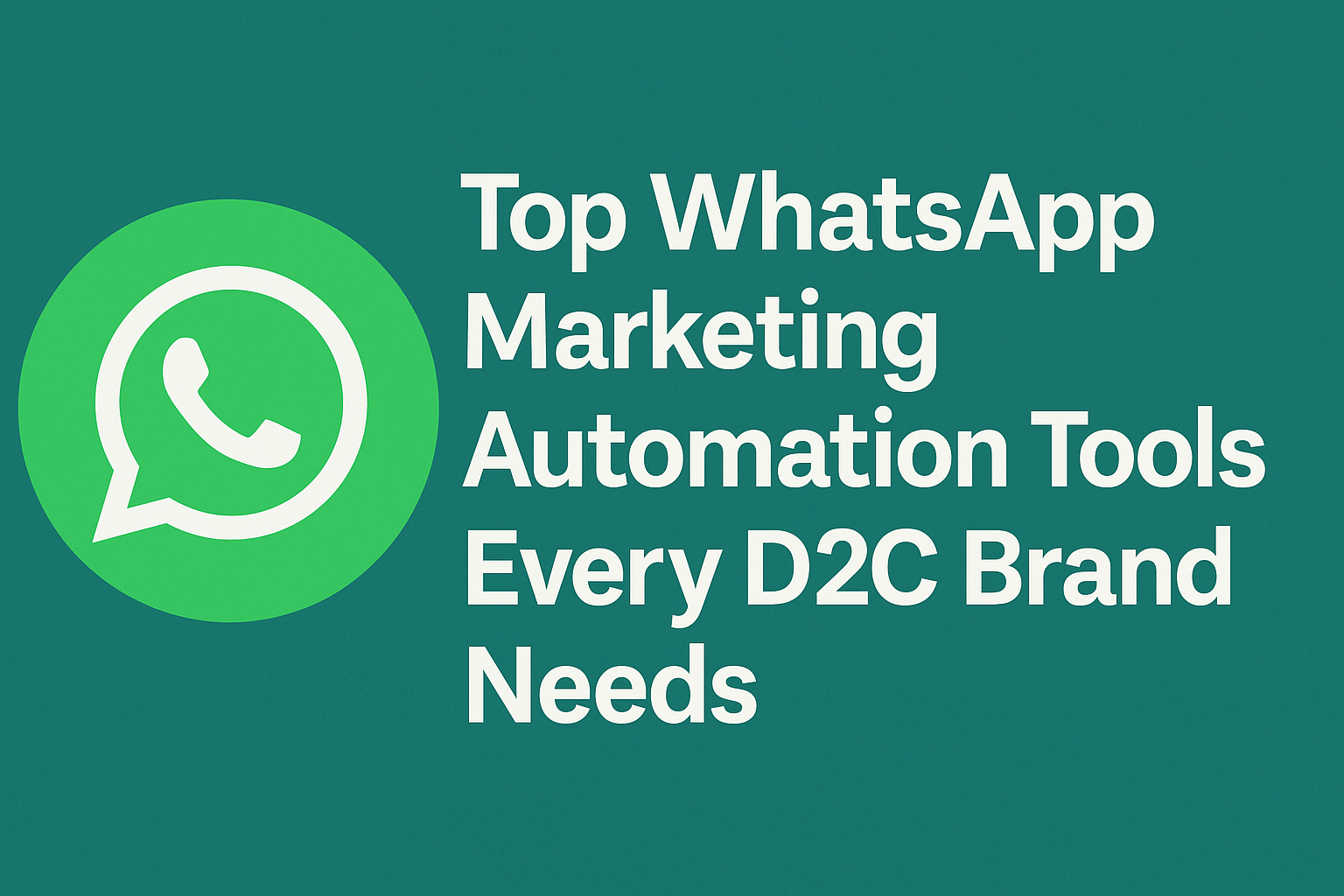
Introduction WhatsApp is now the most powerful direct-to-consumer channel—with 98% open rates and real-time delivery. But it’s not just about sending messages; it’s about building meaningful customer journeys. That’s where The Bot Mode steps in. Designed for D2C brands, The Bot Mode offers end-to-end WhatsApp marketing automation, converting conversations into conversions with ease. In this blog, you’ll explore why The Bot Mode is the must-have automation tool for WhatsApp marketing and how it stacks up against generic platforms. Why WhatsApp Marketing Automation is Vital for D2C Brands Key Features of The Bot Mode for D2C Brands Use Cases: How D2C Brands Win with The Bot Mode Why The Bot Mode Outperforms Traditional WhatsApp Tools Feature The Bot Mode Generic Tools D2C Specialization ✅ Yes ❌ No Built-in eCommerce Flows ✅ Shopify/WooCommerce Ready ❌ Limited integrations Smart Chatbot Builder ✅ NLP & AI powered ⚠️ Basic templates Campaign Automation ✅ Drip, Segmented ⚠️ One-time blasts Compliance Support ✅ GDPR-ready ⚠️ Requires manual setup Best Practices to Maximize The Bot Mode’s Impact Future Trends in WhatsApp Marketing You Can Leverage with The Bot Mode Conclusion For D2C brands, WhatsApp is more than a messaging app—it’s a full-fledged conversion channel. The Bot Mode offers the automation backbone you need to scale customer communication, increase conversions, and reduce support costs. Whether you’re just launching or scaling globally, The Bot Mode adapts to your growth and elevates your marketing game. FAQs Q1: What makes The Bot Mode ideal for D2C?It’s tailored for commerce—from cart recovery to reorder flows, all automated. Q2: Can I personalize my WhatsApp broadcasts?Yes, using tags like {{name}}, {{order_id}}, etc., within The Bot Mode. Q3: Is The Bot Mode API-based or no-code?Both. You can use its visual builder or API for deeper integrations. Q4: How fast can I go live?Most brands are up and running in under 72 hours. Q5: Is it GDPR-compliant?Absolutely. The Bot Mode follows all major data privacy protocols.
From Chat to Checkout: Optimizing Your WhatsApp Product Catalog
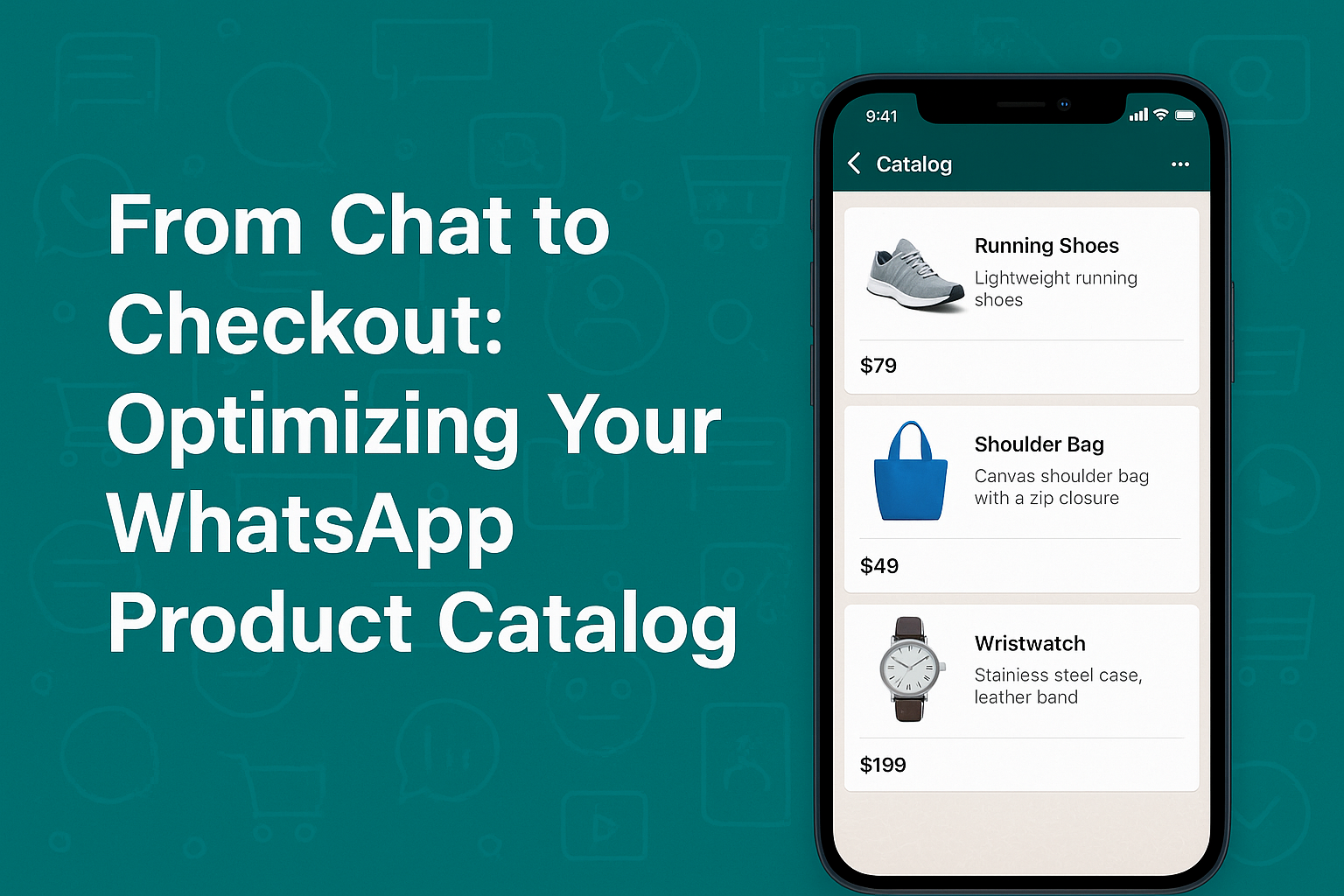
Introduction The way consumers shop is evolving rapidly, and conversational commerce is leading the charge. With over 2 billion users worldwide, WhatsApp Business offers a powerful tool for brands to showcase products, streamline discovery, and close sales—all within a single conversation. For modern businesses aiming to boost traffic and increase conversions, an optimized WhatsApp product catalog is no longer optional—it’s essential. What Is WhatsApp Product Catalog? WhatsApp’s product catalog is a built-in feature of WhatsApp Business that allows businesses to display up to 500 products or services. Each item includes: It acts as a mobile storefront, offering customers instant access to your products without leaving the app—making browsing and buying easier and faster. Why Your Business Needs an Optimized Catalog An optimized catalog helps you: In short, your catalog isn’t just a product list—it’s a conversion tool. Step‑by‑Step: Set Up with SEO & Voice‑Search in Mind 1. Access & Create Your Catalog Navigate to:WhatsApp Business > Business Tools > Catalog > Add New Item You can add items manually through the app or use WhatsApp Business Manager on desktop for larger uploads. 2. Prepare Optimized Assets 3. Publish & Get Approved WhatsApp auto-reviews your entries. Common rejections include: Keep descriptions honest, and re-upload any rejected content with corrections. Pro Tips: Optimize for Traffic & Conversions AEO & Voice‑Search Enhancements To rank for voice search and featured snippets: These steps align with how Google’s RankBrain and BERT algorithms understand natural language. Integration with The Botmode At The Botmode, we help businesses supercharge their WhatsApp catalogs by automating: Pairing your catalog with smart automation creates a seamless end-to-end experience—from chat to checkout. Conclusion Optimizing your WhatsApp product catalog is more than just an enhancement—it’s a strategy. From cleaner layouts to smarter automation and voice search readiness, each optimization step builds toward higher engagement and sales. Start crafting your catalog today and let The Botmode help you unlock its full power. FAQs 1. What is the maximum number of products I can add? You can add up to 500 products or services to your catalog. 2. How do I organize products into collections? Use the “Collections” feature in WhatsApp Business Tools to group related items for easier browsing. 3. Can I hide products temporarily? Yes, products can be marked as “Out of Stock” or unpublished without deleting them. 4. Will WhatsApp review my images? Yes, every product undergoes automated review to ensure it meets community guidelines. 5. How to share my catalog outside WhatsApp? You can share your catalog link via your website, email, social media, and QR codes.
Post-Purchase WhatsApp Workflows That Drive Repeat Sales

Why Post-Purchase WhatsApp Workflows Matter for D2C Brands The customer journey doesn’t end after checkout—it evolves. For D2C brands, the post-purchase phase is a golden window to build loyalty, foster engagement, and trigger repeat purchases. WhatsApp, with its 95%+ open rates and real-time delivery, is the perfect channel to connect with customers after the sale. Compared to email, WhatsApp offers: Done right, post-purchase WhatsApp automation keeps your brand top-of-mind and increases lifetime customer value. 7 Must-Have Post-Purchase WhatsApp Workflows 1. Order Confirmation & Thank You Send an immediate WhatsApp message once the order is placed to confirm details and express gratitude. Trigger: Order placed → Instant WhatsApp confirmation 2. Shipping & Delivery Updates Automate tracking updates across the delivery journey to reduce WISMO (Where Is My Order) queries. Workflow: Order dispatched → In-transit → Out for delivery → Delivered 3. Feedback & Review Request Gather insights and build credibility by asking for feedback shortly after delivery. Trigger: Order delivered → After 2 days → WhatsApp message with review link 4. Product Usage Tips or Guides Help customers maximize their purchase with how-to tips, usage guides, or styling ideas. Trigger: Order delivered → After 3 days → Tips via WhatsApp 5. Cross-Sell & Upsell Suggestions Leverage purchase history to suggest complementary or upgraded products. Trigger: Order delivered → After 7 days → Personalized product recommendations 6. Replenishment Reminders Perfect for consumables or recurring needs. Automatically remind customers when it’s time to reorder. Trigger: 30 days after purchase → WhatsApp reminder to restock 7. Loyalty & Rewards Notifications Celebrate loyal customers by sending exclusive rewards, offers, or loyalty program updates. Trigger: Customer completes 2+ orders → WhatsApp reward message How TheBotMode Automates These Workflows TheBotMode simplifies WhatsApp automation for D2C brands with: Pre-built post-purchase templates1-click integration with Shopify, WooCommerce & moreSmart segmentation for hyper-personalized outreachReal-time performance analytics You can set up complex workflows in minutes—without writing a single line of code. Best Practices for Post-Purchase WhatsApp Automation Final Thoughts Winning the first sale is just the beginning. With well-designed post-purchase WhatsApp workflows, you can delight customers, reduce support tickets, and increase repeat purchases—all on autopilot. Start automating your post-purchase journeys today with TheBotMode—and turn one-time buyers into loyal brand advocates. FAQs: Q1. What is a post-purchase WhatsApp workflow? It’s an automated series of messages sent via WhatsApp after a customer makes a purchase—used to update, engage, and re-sell. Q2. Can small D2C brands benefit from this? Absolutely. Platforms like TheBotMode make it easy for small teams to implement these workflows with minimal effort. Q3. Are these messages allowed under WhatsApp’s API policies? Yes, provided you use approved templates and secure opt-in consent from customers. Q4. When should I start sending post-purchase messages? Begin with instant confirmation and continue with updates and feedback requests spread over a few days to weeks. Q5. How do I track results? TheBotMode offers built-in analytics to track opens, clicks, responses, and conversion data.
WhatsApp Campaign Metrics: How to Track Clicks, Conversions, and ROI
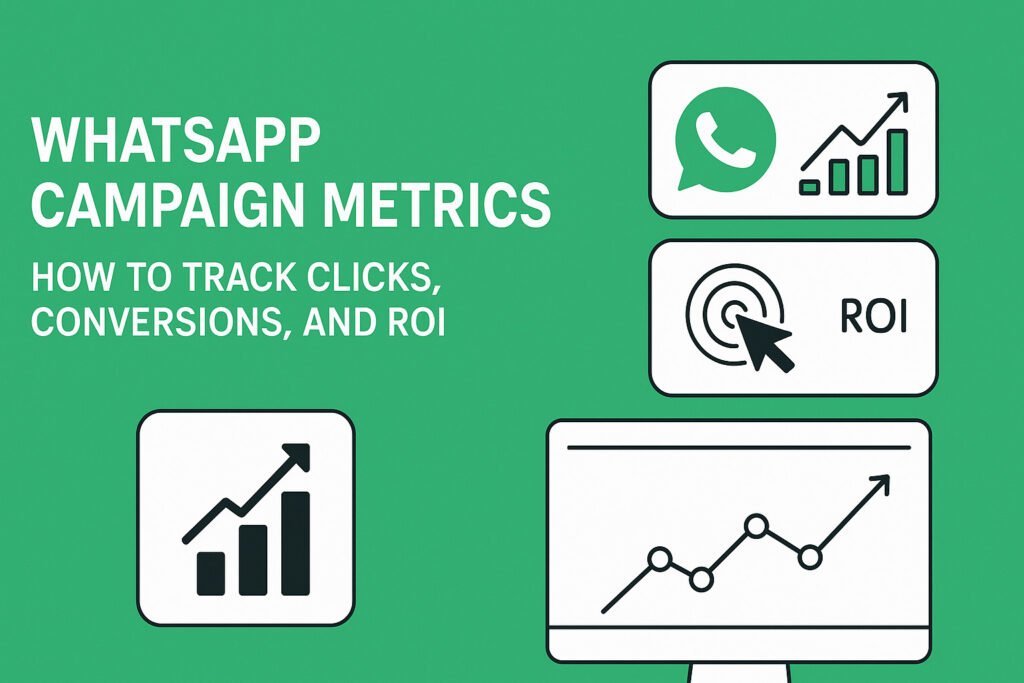
WhatsApp has emerged as a powerful growth channel for D2C brands—offering unmatched reach, high engagement, and direct conversions. But sending messages alone isn’t enough. To drive meaningful results and scale your marketing efforts, you need to understand what’s working and what’s not by tracking the right campaign metrics. In this blog, we’ll break down the essential WhatsApp metrics every brand should track, how to track them effectively, and how TheBotMode can help you unlock smarter, data-driven campaigns. Why WhatsApp Campaign Metrics Matter for D2C Brands Tracking campaign metrics is not just about reporting—it’s about improving performance. With clear insights, you can identify: Without this visibility, you’re just guessing. Key WhatsApp Campaign Metrics You Should Track 1. Delivery Rate Formula:(Delivered Messages ÷ Total Messages Sent) × 100 Why It Matters:A low delivery rate may indicate poor contact data, unverified numbers, or opt-in issues. 2. Open Rate The percentage of delivered messages that were opened by recipients. Why It Matters:WhatsApp typically sees open rates above 95%. If yours is lower, your timing or content may need adjustment. 3. Click-Through Rate (CTR) Formula:(Link Clicks ÷ Delivered Messages) × 100 Why It Matters:CTR reveals how compelling your message is. Use UTM-tagged links to get accurate click data via Google Analytics or TheBotMode dashboards. 4. Conversion Rate Formula:(Conversions ÷ Link Clicks) × 100 Why It Matters:This is your key performance indicator. It tells you if users are taking meaningful actions after clicking, like making a purchase or signing up. 5. Opt-Out Rate Measures how many recipients unsubscribed after receiving your message. Why It Matters:A high opt-out rate signals poor targeting or over-messaging. Monitor this to protect your sender reputation. 6. Response Rate For two-way campaigns, this tracks how many users replied to your message. Why It Matters:This metric helps assess engagement quality and audience trust. 7. WhatsApp Campaign ROI Formula:(Revenue – Campaign Cost) ÷ Campaign Cost × 100 Why It Matters:This is the most business-critical metric. If ROI is low, revisit your messaging, targeting, or offer. How to Track WhatsApp Campaign Metrics Effectively 1. Use UTM Parameters for Links Always add UTM tags to your campaign URLs. This allows you to attribute traffic, engagement, and conversions within Google Analytics. Example:https://yourstore.com/product?utm_source=whatsapp&utm_medium=campaign&utm_campaign=summer_sale 2. Enable WhatsApp Business API Analytics With TheBotMode’s WhatsApp API, you can track: This gives you full control over your messaging performance. 3. Connect WhatsApp with Your Store Using TheBotMode’s Shopify or WooCommerce integration, you can: 4. Use Campaign Dashboards TheBotMode provides dashboards where you can: WhatsApp Campaign Benchmarks for D2C (2025) Metric Industry Benchmark Open Rate 95%+ Click-Through Rate 10%–20% Conversion Rate 5%–10% Opt-Out Rate Below 1% ROI 5x–10x (Varies by niche) Source: TheBotMode internal customer data (2025) Conclusion Great WhatsApp marketing isn’t just about sending messages—it’s about continuously learning from your data. By tracking key performance metrics, D2C brands can fine-tune their messaging, improve conversion rates, and generate better ROI from every campaign. TheBotMode gives you the tools to do exactly that—track, measure, and scale with confidence. FAQs Q1: How can I track clicks on WhatsApp messages?Use UTM-tagged links and track click data in Google Analytics or TheBotMode’s dashboard. Q2: What’s a good WhatsApp conversion rate for D2C brands?A strong conversion rate is between 5% to 10%, depending on your offer and audience. Q3: Can I track revenue from WhatsApp campaigns?Yes, by integrating TheBotMode with Shopify, WooCommerce, or CRMs, you can see direct revenue attribution. Q4: What’s the average ROI from WhatsApp campaigns?Most brands see 5x–10x returns, though results vary based on targeting and content quality. Q5: Does TheBotMode offer in-depth campaign analytics?Yes. TheBotMode offers detailed analytics including delivery status, clicks, replies, conversions, and ROI.
From Cart Abandonment to Conversion: WhatsApp Automations for D2C
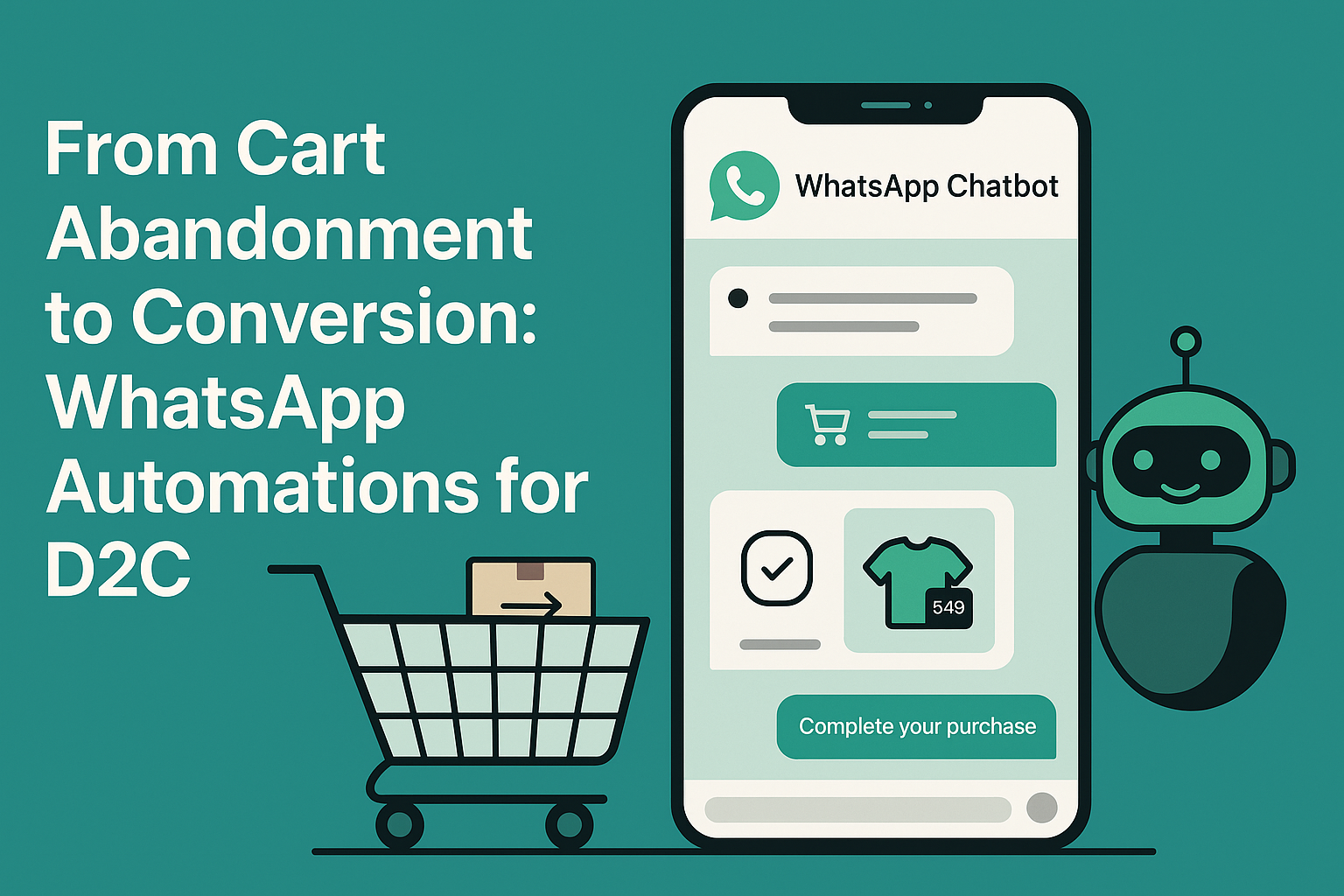
🛒 The Cart Abandonment Problem in D2C E-commerce D2C brands invest heavily in driving traffic to their online stores—yet more than 70% of shopping carts are abandoned before checkout. That’s a significant revenue leak. Why do customers drop off at the last minute? Traditional re-engagement methods like email or retargeting ads often fall short due to low open rates and banner blindness. This is where WhatsApp Automation steps in. 📱 Why WhatsApp Works for Cart Recovery WhatsApp is not just another messaging app—it’s a real-time, personal engagement channel with 98% open rates and exceptional click-throughs. For D2C brands, this means: WhatsApp delivers what email can’t: instant, human-like conversations that convert. ⚙️ Key WhatsApp Automation Flows to Convert Abandoned Carts ⏱ Abandoned Cart Reminders with Smart Timing Trigger personalized WhatsApp messages 1–2 hours after cart abandonment. Include: 🎁 Limited-Time Discounts or Triggered Offers Entice users with urgency-driven messages like: “You forgot something! Here’s 10% off if you check out in the next 30 minutes.” This strategy increases urgency and drastically improves recovery rates. 🗨️ Conversational Product Support Let users ask questions mid-purchase via chatbot automation: The bot replies instantly, increasing trust and removing purchase friction. Escalate to live chat when needed. 🤖 How TheBotMode’s WhatsApp Chatbot Powers These Automations The Botmode WhatsApp Chatbot is purpose-built for D2C ecommerce. Our platform enables: With a few clicks, you can build a full-funnel automation that runs 24/7. 📊 Real Results: WhatsApp Automation in Action One D2C beauty brand using TheBotMode recovered 31% of abandoned carts within 7 days by implementing personalized WhatsApp flows with discount triggers and FAQ automation. Another apparel brand doubled its opt-in rate by running Instagram click-to-WhatsApp ads tied directly to limited-time cart offers. 🎯 WhatsApp for Lead Generation Beyond Cart Recovery Cart recovery is only the beginning. Use WhatsApp to: Unlike cold emails, WhatsApp contacts are high-intent leads—they opted in to talk. 🚀 Getting Started: Launch Your WhatsApp Cart Automation with TheBotMode Ready to convert missed opportunities into sales? ✅ Connect your e-commerce platform✅ Design your abandoned cart flow✅ Start capturing and converting leads today 👉 Try The BotMode’s WhatsApp Chatbot Now and turn conversations into conversions. ❓ FAQs Q1: What is WhatsApp cart recovery automation?It’s an automated WhatsApp message sequence triggered when a user abandons their shopping cart, reminding and encouraging them to complete the purchase. Q2: How does WhatsApp chatbot improve lead generation?It captures user data in real time, engages them in conversation, and nurtures interest through personalized messaging. Q3: Can WhatsApp automations integrate with Shopify or WooCommerce?Yes, TheBotMode supports deep integration with Shopify, WooCommerce, and other major platforms. Q4: Is it GDPR-compliant to use WhatsApp for re-marketing?Absolutely. Users must opt-in before receiving messages, and TheBotMode ensures all flows are compliant. Q5: How quickly can I see results from cart recovery automation?Most brands see measurable improvements in conversions within the first week of implementation.
Cut RTO by 30%: Use WhatsApp to Convert COD Orders to Prepaid
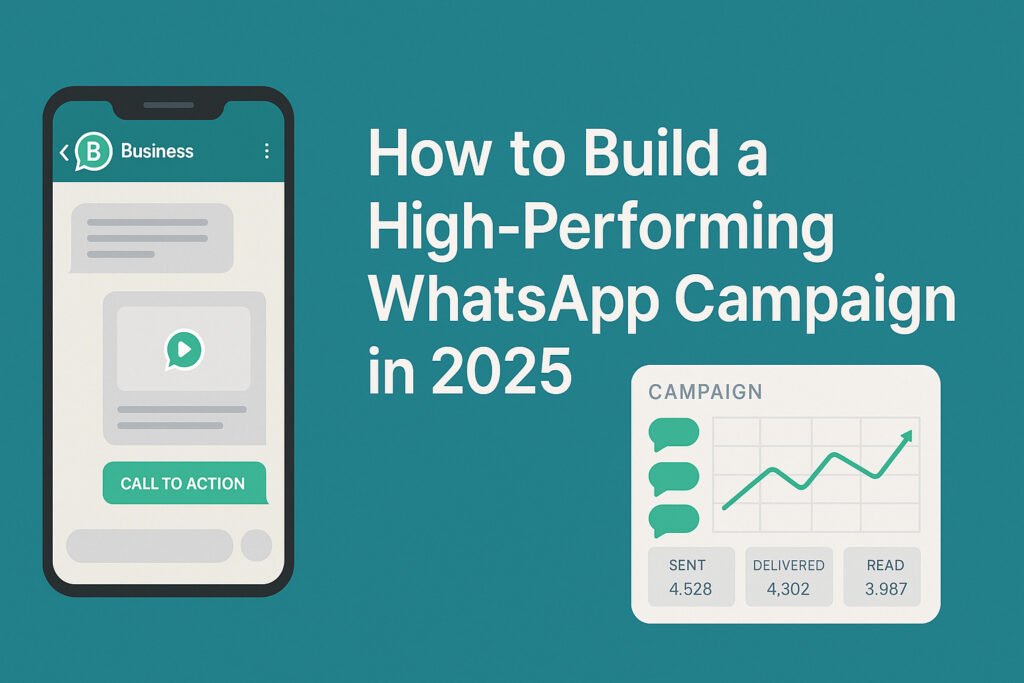
Why RTO Is a Growing Threat for D2C Brands In the fast-moving world of direct-to-consumer (D2C) e-commerce, cash on delivery (COD) continues to dominate as a preferred payment method. However, it’s also one of the biggest contributors to high Return to Origin (RTO) rates. Failed deliveries, customer rejections, and non-serious buyers result in significant losses for brands. RTO not only increases logistics costs but also ties up inventory, impacts margins, and erodes trust with delivery partners. D2C brands need a scalable way to reduce RTO while maintaining a seamless customer experience. How WhatsApp Automation Reduces RTO by 30% WhatsApp, with its 98% open rate and high engagement, is the perfect channel for turning COD into prepaid. Using smart automation flows, brands can engage customers post-order to encourage upfront payments. Here’s how: Proactive Customer Engagement Post-Purchase Immediately after a COD order is placed, send an automated WhatsApp message confirming the order and gently nudging the customer with a payment option. Offering Instant Prepaid Discounts A simple incentive—like a 5% discount or cashback on prepaid—can drive a significant number of COD customers to switch to prepaid. Real-Time Order Confirmation via Chat Use interactive WhatsApp messages to confirm whether the customer intends to accept delivery. This helps filter out high-risk RTO orders before they are dispatched. Leveraging Interactive CTAs Incorporate clickable CTAs like “Pay Now” or “Switch to Prepaid” directly in the chat. Integrate these with Razorpay, PayU, or any UPI payment gateway for seamless transactions. Step-by-Step WhatsApp Flow to Convert COD Orders to Prepaid Trigger Automation As soon as a COD order is placed on your website, an automated WhatsApp message is sent to the customer. Incentive Presentation The message clearly explains the benefit (e.g., 10% off if prepaid within the next 10 minutes), creating urgency and value. Integrated Payment Link Include a secure and pre-filled payment link so the customer can pay with a single tap, avoiding friction. Instant Payment Confirmation Once paid, the order is automatically updated to prepaid in your system, ensuring faster shipping and reducing the chance of refusal on delivery. The Bot Mode Advantage 🔗 Convert COD Orders to Prepaid with The Botmode The Bot Mode makes this entire process turnkey for D2C brands: Results You Can Expect Brands using The Bot Mode have reported: Conclusion Reducing RTO is not just about cutting costs—it’s about reclaiming revenue, improving customer satisfaction, and scaling your D2C brand efficiently. WhatsApp automation offers a high-conversion, low-friction method to convert COD orders into prepaid. With The Bot Mode, the setup is fast, results are measurable, and the impact is significant. Ready to cut RTO and boost prepaid sales? 👉 Start Your WhatsApp Prepaid Flow with The Bot Mode Today FAQs How much can I expect to reduce RTO with WhatsApp automation? D2C brands typically see a 20–30% drop in RTOs when converting even a portion of COD orders to prepaid. Will this solution work with Shopify or WooCommerce? Yes, The Bot Mode integrates directly with Shopify, WooCommerce, and other major platforms for easy deployment. What kind of incentives work best for prepaid conversions? Discounts (5–10%), free shipping, or wallet cashback work well. The key is to offer limited-time value. Is WhatsApp automation GDPR and DPDP-compliant? Yes, all customer data handling is compliant with data privacy laws including GDPR and India’s DPDP regulations.













